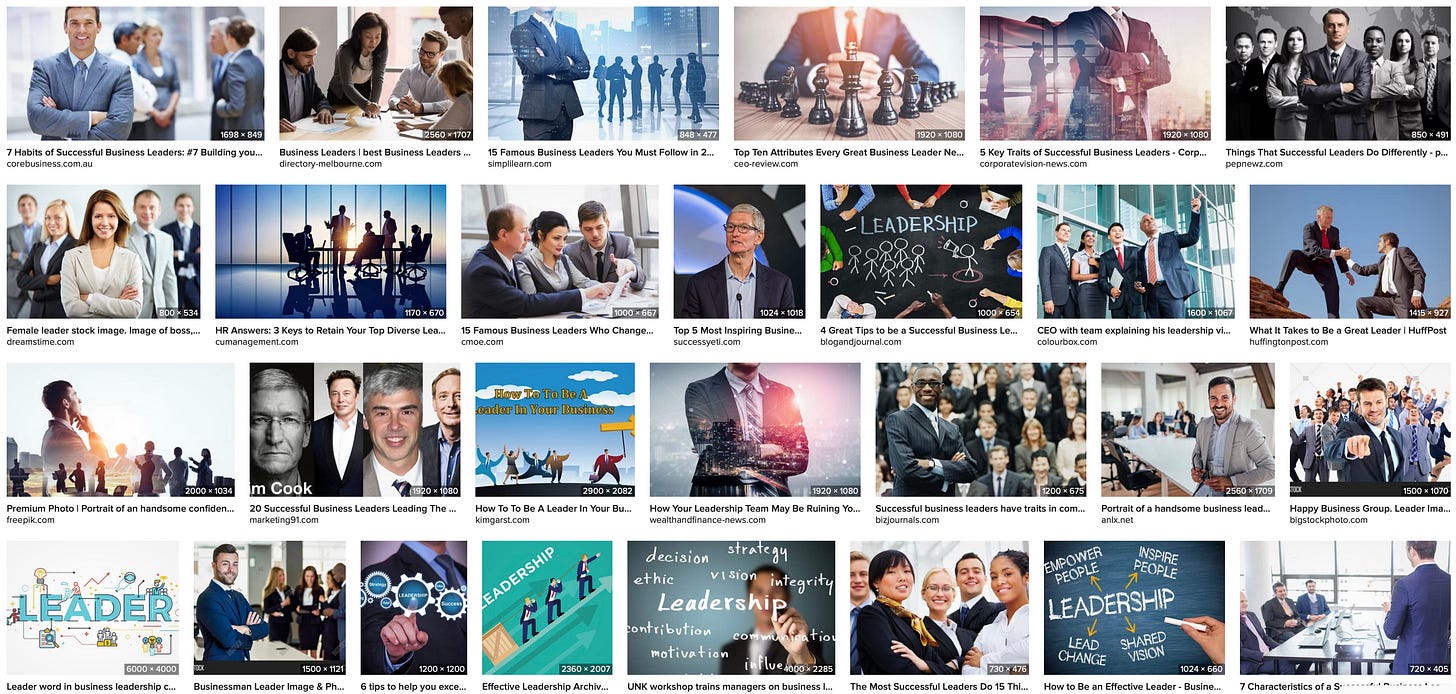Close your eyes and imagine a leader. Maybe you think of someone in a sharp suit, standing at the head of a boardroom table, confidently making decisions for their team. Or maybe it’s a politician (or heck, maybe it’s a fascist dictator) giving a rousing speech. Leaders are usually seen as someone in charge, giving orders that others follow.
But doesn’t that image feel… tired?
It’s the human equivalent of a stock photo: boring, outdated, painfully cliché. It’s steeped in biases, excluding anyone who doesn’t look or act the part. And it ignores the quiet, revolutionary leadership happening every single day in places far from boardrooms or podiums. So let’s ask the real question: Who gets to be a leader? And why do so many of us (especially women, people of color, and anyone who doesn’t fit traditional molds) feel like we’ll never measure up?
Spoiler alert: it’s not because you’re not a leader. It’s because you were never meant to feel like one.
The Problem with the Old Rules
For centuries, leadership has been framed by systems that prioritize domination, hierarchy, and control. The old rules of leadership glorify power over others, and a “leader” was someone who commanded respect through fear, charisma, money, or brute force. It’s a model rooted in white supremacy, patriarchy, and capitalism; structures that were designed to benefit the people at the top of the hierarchy at the expense of people at the bottom.
We’ve made some progress, for sure. Most people recognize that leading through fear and domination is not effective or frankly very much fun. We know about the importance of emotional intelligence in leaders, of leading with collaboration and empathy, and we see that true leadership is about inspiring and guiding people toward collective goals rather than dominating them through authority and control.
But the old rules haven’t totally disappeared. We still equate leadership with titles, public recognition, and traditional metrics of success. And let’s not ignore the global rise in authoritarianism that embodies some of these traditional, stereotypical leadership qualities.
Leadership, as society often defines it, still comes with a rigid and exclusionary playbook. And if you don’t play by these rules, you’ll end up losing the game.
It’s Not Imposter Syndrome
When I work with women in leadership roles, or who aspire to be leaders someday, we inevitably come across the idea of imposter syndrome, that sneaking suspicion that you’re just not good enough or qualified enough to be in the position you’re in. Does this sound like you? That nagging sense that you’re “playing leader” rather than owning it? Let me stop you right there - you’re not alone. It’s a story I hear all the time, especially from women working in male-dominated spaces.
But the problem isn’t you. This isn’t a personal failing. It’s a structural one.
"Imposter syndrome directs our view toward fixing women at work instead of fixing the places where women work." Stop Telling Women They Have Imposter Syndrome, by Ruchika Tulshyan and Jodi-Ann Burey, February 11, 2021
As the authors of this Harvard Business Review article point out, imposter syndrome has been pathologized, especially in women and marginalized groups, as if it’s a personal flaw we need to overcome. In reality, it’s a predictable response to navigating workplaces and cultures designed without us in mind.
When leadership is defined by outdated dominance, competitiveness, and that swaggering “bro” confidence, it’s no wonder so many of us feel like we don’t fit. The truth is, the system makes us feel inadequate because it doesn’t reflect or value the strengths we bring: empathy, collaboration, and a willingness to lead differently.
Rebel Leaders: A New Definition of Leadership
Let’s flip the script. Leadership isn’t about power over others; it’s about power with others.
It’s about collaboration, empathy, and vision. It’s about inspiring change and holding space for others to thrive. And yes, it happens in boardrooms, but it also happens at kitchen tables, in classrooms, in protests, in art, and in countless other places.
Let’s think of a few examples, shall we?
Leadership is a mother teaching her kids to challenge injustice and speak up for what’s right.
Leadership is a disability activist emailing her city council to demand ramps in a new retail development.
Leadership is a farmworker texting his friend and family to rally for fair wages after a grueling day in the fields.
Leadership is a male co-worker writing an email to HR that his female colleague unfairly earns less money than he does.
Leadership is a high school student nervously asking their friends to use they/them pronouns.
Leadership is a father standing before the school board, asking for more resources for neurodivergent kids.
These acts don’t make headlines. It’s likely none of these people think of themselves as leaders. They don’t come with titles or a big, fat paycheck. But this is the new definition of leadership we’re leaning into: intentional, courageous, inclusive, and rooted in a vision for something better.
Who Gets to Be a Leader? You Do.
Take a moment to reflect on your own life. Where are you already leading? It might not look like what society traditionally labels as leadership, but that doesn’t make it any less valid or important.
Ask yourself:
Where am I creating change? Maybe in your home, workplace, or community.
What are my unique strengths as a leader? Think empathy, creativity, resilience, or vision.
How do I define leadership? Challenge the old ideas and make it your own.
The world doesn’t need more traditional leaders playing by the same old rules. It needs rebel leaders who are creating a new game where more people get to win. The world needs leaders who dare to lead with empathy, inclusion, and equity. Leaders like you.
So, how are you already leading? Share your story in the comments or with someone who needs to hear this today.




